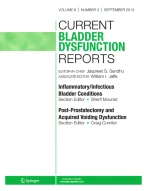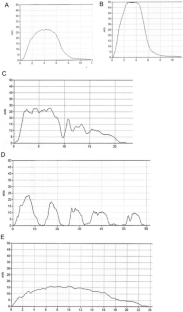How to Diagnose Dysfunctional Voiding

This review aims to discuss the diagnosis and assessment of dysfunctional voiding in both children and adults.
Recent Findings
Although the pillars of diagnosing dysfunctional voiding are a history, physical exam, and uroflowmetry with electromyography or urodynamics, new technology may aid in this evaluation. The use of urinary biomarkers may be a helpful, non-invasive adjunct in diagnosis. In addition, novel devices and smartphone apps may make diagnosis more accessible to patients and providers.
Summary
Dysfunctional voiding refers to the condition where there is a lack of coordination between the sphincter and detrusor muscle during bladder emptying in the absence of anatomic or neurologic cause. Commonly diagnosed in children, this condition may persist or be diagnosed de novo in adulthood. As such, thorough evaluation is critical to diagnosis to prevent recurrent infections and deterioration of the upper urinary tract. Uroflowmetry, with or without electromyography, and/or urodynamics remain the gold standard for diagnosis, while new technology may facilitate evaluation.
This is a preview of subscription content, log in via an institution to check access.
Access this article
Subscribe and save
Springer+ Basic
€32.70 /Month
- Get 10 units per month
- Download Article/Chapter or eBook
- 1 Unit = 1 Article or 1 Chapter
- Cancel anytime
Buy Now
Price includes VAT (France)
Instant access to the full article PDF.
Rent this article via DeepDyve


Similar content being viewed by others
Non-invasive Testing and Its Role in Diagnosis and Management of Children With Voiding Dysfunction
Article 11 April 2018
Dysfunctional voiding: the importance of non-invasive urodynamics in diagnosis and treatment
Article Open access 31 May 2017
The Role of Non-invasive Testing in Evaluation and Diagnosis of Pediatric Lower Urinary Tract Dysfunction
Article 06 April 2018
References
Papers of particular interest, published recently, have been highlighted as: • Of importance •• Of major importance
- Everaert K, Van Laecke E, De Muynck M, Peeters H, Hoebeke P. Urodynamic assessment of voiding dysfunction and dysfunctional voiding in girls and women. Int Urogynecology J. 2000;11:254–64. ArticleCASGoogle Scholar
- Hinman F, Baumann FW. Vesical and ureteral damage from voiding dysfunction in boys without neurologic or obstructive disease. J Urol. 1973;109:727–32. ArticleCASPubMedGoogle Scholar
- Allen TD. The non-neurogenic neurogenic bladder. J Urol. 1977;117:232–8. ArticleCASPubMedGoogle Scholar
- Abrams P, Cardozo L, Fall M, Griffiths D, Rosier P, Ulmsten U, van Kerrebroeck P, Victor A, Wein A, Standardisation Sub-committee of the International Continence Society. The standardisation of terminology of lower urinary tract function: report from the Standardisation Sub-committee of the International Continence Society. Neurourol Urodyn. 2002;21:167–78. ArticlePubMedGoogle Scholar
- Austin PF, Bauer SB, Bower W, et al. The standardization of terminology of lower urinary tract function in children and adolescents: update report from the standardization committee of the International Children’s Continence Society. Neurourol Urodyn. 2016;35:471–81. ArticlePubMedGoogle Scholar
- Sinha S. Dysfunctional voiding: a review of the terminology, presentation, evaluation and management in children and adults. Indian J Urol IJU J Urol Soc India. 2011;27:437–47. ArticleGoogle Scholar
- Feldman AS, Bauer SB. Diagnosis and management of dysfunctional voiding. Curr Opin Pediatr. 2006;18:139–47. ArticlePubMedGoogle Scholar
- Fernandez-Ibieta M, Ayuso-Gonzalez L. Dysfunctional voiding in pediatrics: a review of pathophysiology and current treatment modalities. Curr Pediatr Rev. 2016;12:292–300. ArticlePubMedGoogle Scholar
- Groutz A, Blaivas JG, Pies C, Sassone AM. Learned voiding dysfunction (non-neurogenic, neurogenic bladder) among adults. Neurourol Urodyn. 2001;20:259–68. ArticleCASPubMedGoogle Scholar
- Hinman F. Nonneurogenic neurogenic bladder (the Hinman syndrome)--15 years later. J Urol. 1986;136:769–77. ArticlePubMedGoogle Scholar
- Sandri S. 470 - Adult follow up of major dysfunctional voiding in children. Eur Urol Suppl. 2017;16:e817–8. ArticleGoogle Scholar
- Clothier JC, Wright AJ. Dysfunctional voiding: the importance of non-invasive urodynamics in diagnosis and treatment. Pediatr Nephrol. 2018;33:381–94. ArticlePubMedGoogle Scholar
- Swinn MJ, Fowler CJ. Isolated urinary retention in young women, or Fowler’s syndrome. Clin Auton Res Off J Clin Auton Res Soc. 2001;11:309–11. ArticleCASGoogle Scholar
- Morin F, Akhavizadegan H, Kavanagh A, Moore K. Dysfunctional voiding: challenges of disease transition from childhood to adulthood. Can Urol Assoc J J Assoc Urol Can. 2018;12:S42–7. ArticleGoogle Scholar
- Özen MA, Mutluer T, Necef I, Shabsog M, Taşdemir M, Bilge I, Eroğlu E. The overlooked association between lower urinary tract dysfunction and psychiatric disorders: a short screening test for clinical practice. J Pediatr Urol. 2019;15:332.e1–5. ArticlePubMedGoogle Scholar
- Ho G-R, Wei C-W, Kuo H-C. Voiding dysfunction due to urethral sphincter dysfunction might be an early neurological presentation of central nervous system disorders in aged patients. J Pers Med. 2023;13:693. ArticlePubMedPubMed CentralGoogle Scholar
- Jiang R, Kelly MS, Routh JC. Assessment of pediatric bowel and bladder dysfunction: a critical appraisal of the literature. J Pediatr Urol. 2018;14:494–501. ArticleCASPubMedPubMed CentralGoogle Scholar
- Farhat W, Bägli DJ, Capolicchio G, O’Reilly S, Merguerian PA, Khoury A, McLorie GA. The dysfunctional voiding scoring system: quantitative standardization of dysfunctional voiding symptoms in children. J Urol. 2000;164:1011–5. ArticleCASPubMedGoogle Scholar
- Nelson CP, Park JM, Bloom DA, Wan J, Dunn RL, Wei JT. Incontinence Symptom Index-Pediatric: development and initial validation of a urinary incontinence instrument for the older pediatric population. J Urol. 2007;178:1763–7. discussion 1767 ArticlePubMedGoogle Scholar
- Sureshkumar P, Craig JC, Roy LP, Knight JF. A reproducible pediatric daytime urinary incontinence questionnaire. J Urol. 2001;165:569–73. ArticleCASPubMedGoogle Scholar
- Ebiloglu T, Kaya E, Kopru B, Ergin G, Sahin S, Irkilata HC, Kibar Y. Concised form for lower urinary tract dysfunction symptom scale in children. J Clin Diagn Res JCDR. 2016;10:PC04–6. PubMedGoogle Scholar
- Krishnappa P, Sinha M, Krishnamoorthy V. A prospective study to evaluate the efficacy of botulinum toxin-a in the management of dysfunctional voiding in women. Clin Med Insights Womens Health. 2018;11
- • Chiang C-H, Jiang Y-H, Kuo H-C. Therapeutic efficacy of biofeedback pelvic floor muscle exercise in women with dysfunctional voiding. Sci Rep. 2021;11:13757. Study that highlighted the clinical tools used to diagnose dysfunctional voidingArticleADSCASPubMedPubMed CentralGoogle Scholar
- Cameron AP, Wiseman JB, Smith AR, et al. Are Three-Day Voiding Diaries Feasible and Reliable? Results from the Symptoms of Lower Urinary Tract Dysfunction Research Network (LURN) Cohort. Neurourol Urodyn. 2019;38:2185–93. ArticlePubMedPubMed CentralGoogle Scholar
- López-Fando L, Santiago M, Ruiz M, et al. Is the first day of the bladder diary enough for symptom assessment in women with lower urinary tract symptoms? Continence. 2022;2:100026. ArticleGoogle Scholar
- Lopes I, Veiga ML, Braga AA, Brasil CA, Hoffmann A, Barroso U Jr. A two-day bladder diary for children: is it enough? J Pediatr Urol. 2015;11:348.e1–4. ArticleCASPubMedGoogle Scholar
- Mateu Arrom L, Peri Cusi L, López-Fando L, Franco de Castro A, Jiménez Cidre MÁ, Alcaraz A. Validation of a 3 day electronic bladder diary as an app for smart-phone. Neurourol Urodyn. 2019;38:764–9. ArticlePubMedGoogle Scholar
- Whangbo T-K, Eun S-J, Jung E-Y, Park DK, Kim SJ, Kim CH, Chung KJ, Kim K-H. Personalized urination activity recognition based on a recurrent neural network using smart band. Int Neurourol J. 2018;22:S91–100. ArticlePubMedPubMed CentralGoogle Scholar
- Fuentes M, Magalhães J, Barroso U. Diagnosis and management of bladder dysfunction in neurologically normal children. Front Pediatr. 2019;7:298. ArticlePubMedPubMed CentralGoogle Scholar
- Quaghebeur J, Petros P, Wyndaele J-J, De Wachter S. Pelvic-floor function, dysfunction, and treatment. Eur J Obstet Gynecol Reprod Biol. 2021;265:143–9. ArticlePubMedGoogle Scholar
- • Jiang Y-H, Jhang J-F, Ho H-C, Hsu Y-H, Kuo H-C. Diagnostic and prognostic value of urine biomarkers among women with dysfunctional voiding. Sci Rep. 2022;12:6608. Novel use of biomarkers in diagnosing dysfunctional voidingArticleADSCASPubMedPubMed CentralGoogle Scholar
- Siddiqui NY, Helfand BT, Andreev VP, et al. Biomarkers implicated in lower urinary tract symptoms: systematic review and pathway analyses. J Urol. 2019;202:880–9. ArticlePubMedPubMed CentralGoogle Scholar
- Van Batavia JP, Combs AJ. The role of non-invasive testing in evaluation and diagnosis of pediatric lower urinary tract dysfunction. Curr Urol Rep. 2018;19:34. ArticlePubMedGoogle Scholar
- Ballstaedt L, Woodbury B. Bladder post void residual volume. StatPearls; 2023. Google Scholar
- Chang S-J, Chiang I-N, Hsieh C-H, Lin C-D, Yang SS-D. Age- and gender-specific nomograms for single and dual post-void residual urine in healthy children. Neurourol Urodyn. 2013;32:1014–8. ArticlePubMedGoogle Scholar
- Scarpero H. Urodynamics in the evaluation of female LUTS: when are they helpful and how do we use them? Urol Clin North Am. 2014;41:429–38. ArticlePubMedGoogle Scholar
- Tangal S, Gökçe Mİ, Özayar A, Gülpınar B, Haliloğlu AH, Burgu B, Özdiler E. Evaluation of a new ultrasound measurement tool for the diagnosis of dysfunctional voiding in pediatric population: full/empty bladder wall thickness ratio. Urology. 2014;83:1369–72. ArticlePubMedGoogle Scholar
- Chan L. Pelvic ultrasound in the assessment of female voiding dysfunction. In: Chan L, Tse V, The S, Stewart P, editors. Pelvic floor ultrasound Princ. Appl. Case Stud. Cham: Springer International Publishing; 2015. p. 63–76. ChapterGoogle Scholar
- Stoffel JT, Peterson AC, Sandhu JS, Suskind AM, Wei JT, Lightner DJ. AUA white paper on nonneurogenic chronic urinary retention: consensus definition, treatment algorithm, and outcome end points. J Urol. 2017;198:153–60. ArticlePubMedGoogle Scholar
- Franco I, Shei-Dei Yang S, Chang S-J, Nussenblatt B, Franco JA. A quantitative approach to the interpretation of uroflowmetry in children. Neurourol Urodyn. 2016;35:836–46. ArticlePubMedGoogle Scholar
- Dayanc MM, Kibar Y, Irkilata HC, Sancaktutar AA, Ebiloglu T, Gur A, Ergin G, Alp BF, Gok F. Effect of voided volume on voiding patterns and reliability of uroflowmetry-electromyography results in children with lower urinary tract dysfunction. Low Urin Tract Symptoms. 2017;9:46–51. ArticlePubMedGoogle Scholar
- Winters JC, Dmochowski RR, Goldman HB, et al. Urodynamic studies in adults: AUA/SUFU guideline. J Urol. 2012;188:2464–72. ArticlePubMedGoogle Scholar
- •• Sinha S, Yang CC, Arlandis S, Goldman HB. Female voiding dysfunction: a review of clinical presentation, urodynamic diagnosis and management. Continence. 2023;6:100578. Review on voiding dysfunction in womenArticleGoogle Scholar
- Wenske S, Van Batavia JP, Combs AJ, Glassberg KI. Analysis of uroflow patterns in children with dysfunctional voiding. J Pediatr Urol. 2014;10:250–4. ArticlePubMedGoogle Scholar
- Netto JMB, Hittelman A, Lambert S, Murphy K, Collette-Gardere T, Franco I. Interpretation of uroflow curves: a global survey measuring inter and intra rater reliability. Neurourol Urodyn. 2020;39:826–32. ArticlePubMedGoogle Scholar
- Yang SS-D, Chang S-J. Uroflowmetry and postvoid residual urine tests in incontinent children. In: Pediatr. Incontinence. John Wiley & Sons Ltd; 2015. p. 99–106. ChapterGoogle Scholar
- Gupta DK, Sankhwar SN, Goel A. Uroflowmetry nomograms for healthy children 5 to 15 years old. J Urol. 2013;190:1008–14. ArticlePubMedGoogle Scholar
- Franco I, Franco J, Lee YS, Choi EK, Han SW. Can a quantitative means be used to predict flow patterns: agreement between visual inspection vs. flow index derived flow patterns. J Pediatr Urol. 2016;12:218.e1–8. ArticlePubMedGoogle Scholar
- • Schultz RE. Smartphone app for in-home uroflowmetry. Urol Pract. 2022;9:524–30. New technology for at home uroflowArticlePubMedGoogle Scholar
- Matulewicz RS, Hairston JC. The UroCuff test: a non-invasive alternative to pressure flow studies in adult males with lower urinary tract symptoms secondary to bladder outlet obstruction. Can J Urol. 2015;22:7896–901. PubMedGoogle Scholar
- Khosla L, Codelia-Anjum A, Sze C, Martinez Diaz S, Zorn KC, Bhojani N, Elterman D, Chughtai B. Use of the penile cuff test to diagnose bladder outlet obstruction: a systematic review and meta-analysis. LUTS Low Urin Tract Symptoms. 2022;14:318–28. ArticlePubMedGoogle Scholar
- Glassberg KI, Van Batavia JP, Combs AJ. Can children with either overactive bladder or dysfunctional voiding transition from one into the other: are both part of a single entity? J Pediatr Urol. 2016;12:217.e1–8. ArticlePubMedGoogle Scholar
- Chen Y-C, Kuo H-C. Clinical and video urodynamic characteristics of adult women with dysfunctional voiding. J Formos Med Assoc Taiwan Yi Zhi. 2014;113:161–5. ArticlePubMedGoogle Scholar
- Peng C-H, Chen S-F, Kuo H-C. Videourodynamic analysis of the urethral sphincter overactivity and the poor relaxing pelvic floor muscles in women with voiding dysfunction. Neurourol Urodyn. 2017;36:2169–75. ArticlePubMedGoogle Scholar
- Saxton HM, Borzyskowski M, Mundy AR, Vivian GC. Spinning top urethra: not a normal variant. Radiology. 1988;168:147–50. ArticleCASPubMedGoogle Scholar
- Kutlu O, Koksal IT, Guntekin E, Kukul E. Role of spinning top urethra in dysfunctional voiding. Scand J Urol Nephrol. 2010;44:32–7. ArticlePubMedGoogle Scholar
- • Lee C-L, Chen S-F, Jiang Y-H, Kuo H-C. Effect of videourodynamic subtypes on treatment outcomes of female dysfunctional voiding. Int Urogynecology J. 2022;33:1283–91. How different urodynamic patterns may impact our understanding and outcomes of dysfunctional voidingArticleGoogle Scholar
Funding
No funding was received for this article.



